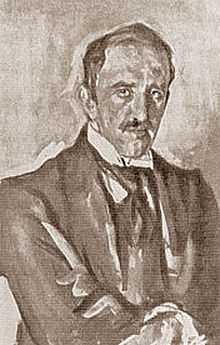Paolo Troubetzkoy

Prince Paolo or Paul Troubetzkoy (Russian: Павел Петрович Трубецкой, Pavel Petrovich Trubetskoy; Intra, Italy, 15 February 1866 — Pallanza, 12 February 1938) was an artist and a sculptor who was described by G.B. Shaw as "the most astonishing sculptor of modern times".
Life

He is the son of Russian diplomat Prince Peter Petrovich Troubetzkoy. He worked in Russia, America, England and Italy. He was a self-taught artist, although he learned sculpture from Giuseppe Grandi. He is associated with impressionism, due to his ability to grasp sketchy movements in his bronze works. He depicted the society of the Belle Époque. Few of his bronzes are still available in the market. Quite famous is the 35 cm high portrait of Constance Stewart-Richardson called "The Dancer".
The largest and best known of his works is the monumental equestrian statue[1] of the Russian Tsar Alexander III in St. Petersburg, Russia. The monument was opened in 1909 on the Nevsky Prospekt near the Moskovsky Vokzal terminal. After the Russian revolution of 1917, the Soviet government removed the monument from the main street to the backyard of the Russian Museum in St. Petersburg. After the collapse of the Soviet Union, the monument to Tsar Alexander III was placed in front of the Marble Palace near the embankment of the Neva river.
Paolo Troubetzkoy:
As I cannot kill, I cannot authorize others to kill. Do you see? If you are buying from a butcher you are authorizing him to kill - to kill helpless creatures which neither you nor I could kill ourselves.
Vegetarianism
Troubetzkoy was a vegetarian. His vegetarian friend Bernard Shaw remarked: “Troubetzkoy is a gigantic and terrifying humanitarian who can do anything with an animal except eat it”. [2]
Alexandra Tolstoy, daughter of the great novelist Leo Tolstoy wrote in her father’s biography: "From time to time he posed – a tiring obligation – for painters and sculptors: for Repin, Pasternak who did a study of the family, Aronson, and Paolo Trubetskoy. Trubetskoy, a Russian educated in Italy, did some splendid little statues of Tolstoy – one of him on horseback. Father was very fond of him. A sweet and childlike person in addition to his great gifts, he read practically nothing, spoke little, all his life was wrapped up in sculpture. As a convinced vegetarian he would not eat meat but cried: “Je ne mange pas de cadavre!” if anyone offered him some. In his studio in St. Petersburg there was a whole zoo: a bear, a fox, a horse, and a vegetarian wolf." [3]
Troubetzkoy once said “As I cannot kill, I cannot authorize others to kill. Do you see? If you are buying from a butcher you are authorizing him to kill – to kill helpless, dumb creatures which neither you nor I could kill ourselves.”[4]
Personal life
Troubetzkoy was married twice. His first marriage was to a Swedish woman, Elin Sundström (1883–1927) and his second marriage was to a British woman named Muriel Marie Beddam. He had no children.
Some works
-

Isaac Levitan, 1899
-

Princess M.N. Gagarina with her daughter, Marina, 1898
-

Grand Duchess Elizabeth Feodorovna, 1899
-

Children (N.S and V.S Troubetzkoys), 1900
-

Sergei Witte with his setter, 1901
-

Friends, 1901
-

Monument to Alexander III of Russia in front of the Marble Palace
-
Lady Standing, 1927, Bass-Dwyer Collection
Expositions
- Paris Expo 1900 (gran premio). In: AIC
- De Young Museum (bust of Michael de Young)
- Biennale di Venezia 1922. (37 works).
- Galleria Nazionale (Rome)
- WWAA 1938
Sources
See also
| Wikimedia Commons has media related to Paolo Troubetzkoy. |
- Troubetzkoy
References
External links
|
